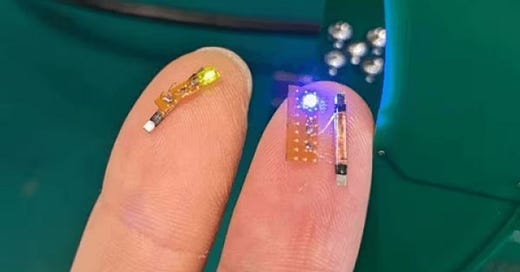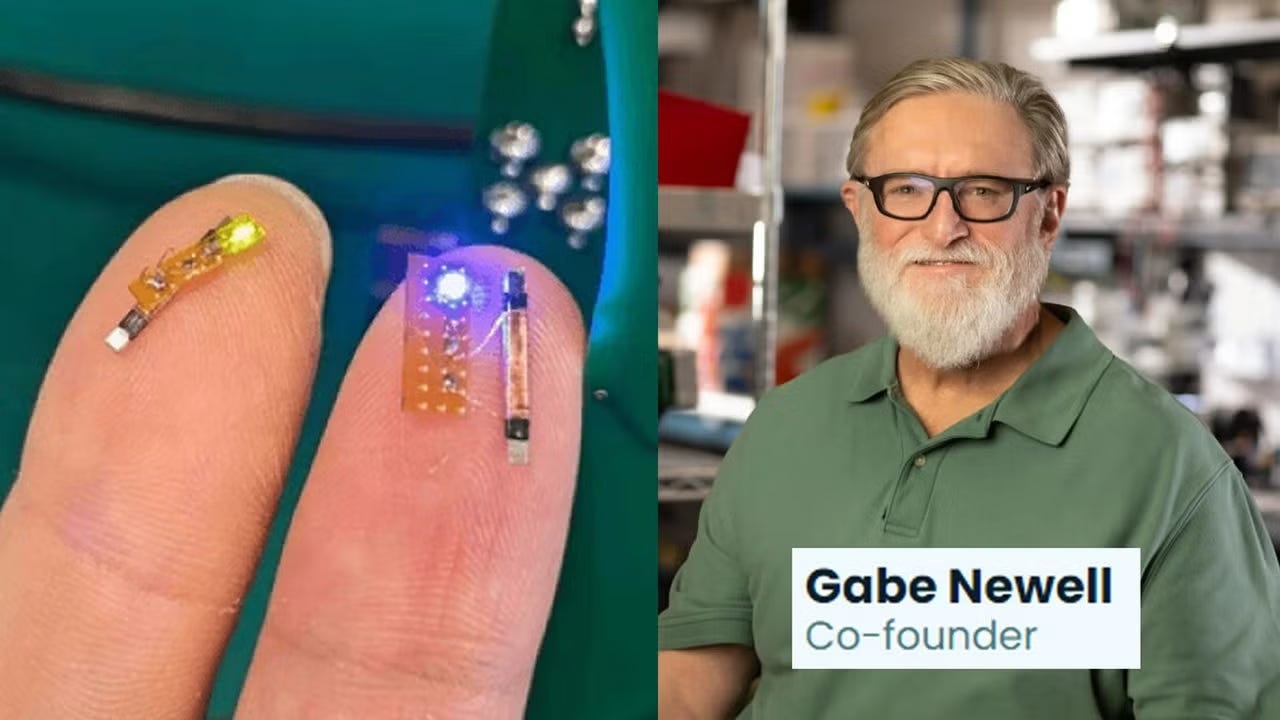Welcome to Neurotech Pulse – Issue #19! In this edition, we explore the latest advancements shaping neurotechnology. Precision Neuroscience’s Layer 7 Cortical Interface earns FDA approval, marking a new milestone for minimally invasive, wireless BCIs, while EPFL introduces a soft brainstem implant for patients who can’t benefit from cochlear implants. Georgia Tech’s microneedle sensors promise seamless brain monitoring, and the MICrONS project unveils an ultra-detailed 3D brain map to decode neural circuits.
This issue’s Case Study Spotlight features Flow Neuroscience, a company developing at-home depression treatment through a brain stimulation headset paired with a behavioral therapy app. We also cover Science Corp’s vision-restoring retinal implant, EEG-to-speech systems enhancing communication, and Inner Cosmos’ minimalist brain implant targeting mental health. Plus, don’t miss our coverage on trends in spinal stimulation, robotic neurorehabilitation, and key investments shaping the neurotech space. Join us as we explore these breakthroughs, funding updates, and thought-provoking insights shaping the future of neurotech!
⚡️Neurotech Newsflash
Cognixion × Blackrock: Expanding Access to Noninvasive BCIs: Blackrock Neurotech will distribute Cognixion’s Axon-R, a noninvasive BCI headset for research and neurorehab, through its global network. While Blackrock stays focused on implants, this partnership brings AI-powered, AR-integrated BCIs to more researchers, bridging noninvasive and implantable neurotech. (Read more)
Synchron’s BCI to Natively Control Apple Devices: Synchron will be the first BCI company to integrate with Apple’s new BCI Human Interface Device (BCI HID) protocol, enabling users to control iPhones, iPads, and Vision Pro with their thoughts. This marks a major leap in accessibility, bringing hands-free, voice-free neural control to everyday devices. (Read more)
Gabe Newell’s BCI Startup to Launch Tiny Brain Chip in 2025: Starfish Neuroscience, founded by Valve’s Gabe Newell, has unveiled a 2×4mm chip that can both read and stimulate brain activity, built for wireless, battery-free implants. Co-developed with imec, the chip targets multi-region neuromodulation with ultra-low power and onboard spike detection. (Read more)
Neuromorphic Chip Mimics Human Vision and Memory: Engineers at RMIT University have developed a tiny neuromorphic device that mimics how the brain processes visual information—detecting motion, storing memories, and reacting in real time without external computing. Made from molybdenum disulfide (MoS₂), the chip uses ultra-low power to perform edge detection and memory encoding, key for real-time decisions in robotics and autonomous systems. (Read more)
Neuralink ALS Patient Edits Video Using Brain Signals: Brad Smith, the first ALS patient with a Neuralink implant, has publicly shared a YouTube video he edited and narrated using only his thoughts. The implant, embedded in his motor cortex, allows him to move a cursor and interact with his MacBook. AI also recreated his voice for narration. The system now helps Smith communicate faster, play video games with his kids, and access digital tools that were previously out of reach, marking a powerful real-world moment in BCI adoption. (Read more)
Axoft’s Ultrasoft BCI Shows Early Success in Human Trial: Axoft has implanted its Fleuron™-based iBCI in four patients, recording stable deep-brain signals during surgery, without drift correction. The implant’s ultrasoft material reduces scarring and captures a potential biomarker of consciousness, marking a major step for long-term, high-fidelity BCIs. (Read more)
💰Notable Funding
Salvia BioElectronics Raises $60M to Advance Implantable Migraine Therapy
Dutch medtech company Salvia BioElectronics closed a $60 million Series B round to fund its MySalvia Therapy — a minimally invasive neuromodulation solution for chronic migraine. The funds will support completion of the RECLAIM clinical trial, regulatory filings, and global launch prep. The FDA-designated Breakthrough Device uses ultra-thin forehead and neck implants activated via an external wearable. (Read more)MindSpire Secures £850K Pre-Seed for Cognitive Wearable: UK-based MindSpire raised £850,000 to develop SONA™, a neuroadaptive wearable targeting stress and focus. The round was led by SFC Capital. (Read more)
INBRAIN Neuroelectronics Awarded €4M Grant for Graphene BCI Development: Spain-based INBRAIN received a €4 million grant under the PERTE Chip initiative to accelerate development of its graphene-based brain-computer interfaces aimed at treating neurological disorders. (Read more)
ClearPoint Neuro Secures $110M from Oberland Capital: ClearPoint Neuro has announced up to $110 million in funding from Oberland Capital to support its real-time MRI-guided neurosurgical navigation and delivery platforms. The investment will drive expansion into gene therapy delivery, neuromodulation, and global commercialization. (Read more)
🧠 Neurotech Trends:
Rewiring Memory: A Dynamic Brain-Inspired Model Emerges: Researchers from UC Santa Barbara and the University of Padua have proposed a new model that better reflects how we recall memories in everyday life. Known as Input-Driven Plasticity (IDP), the model shows how external cues, like just seeing a cat’s tail, can dynamically reshape brain activity to retrieve the full memory. Unlike older models that assume memory recall begins from a static starting point, IDP captures a more fluid, adaptive process. It filters out weaker memory traces, adapts to noisy inputs, and offers a blueprint for building AI systems that are more context-aware, continuous, and flexible, much like the human brain. (Read more)
Stabilizing BCIs by Aligning Latent Neural Dynamics: A new study in Nature Communications proposes a breakthrough method to solve one of BCI’s biggest challenges—neural drift. Researchers from Columbia and collaborators have shown that by aligning latent neural dynamics—the hidden structure beneath raw brain signals—brain-computer interfaces can maintain stable performance over time without frequent recalibration. The approach uses unsupervised manifold alignment to track the brain’s “intent” even as signals shift due to plasticity or electrode movement. Validated in non-human primates, this method paves the way for longer-lasting, adaptive BCIs that better mirror the brain’s intrinsic computational geometry. It could extend to neuroprosthetics, closed-loop systems, and even psychiatric applications. (Read more)
Transcranial Ultrasound Stimulation (TUS) Gains Ground as a Scalable Neurotech Tool: A new 20-year bibliometric review shows Transcranial Ultrasound Stimulation (TUS) rapidly rising as a promising noninvasive neuromodulation technique. Once limited to preclinical research, TUS is now being explored for clinical use in stroke rehabilitation, Parkinson’s, Alzheimer’s, and chronic pain. The review highlights a sharp spike in global research activity peaking in 2024, with growing calls for multicenter trials and standardized protocols. TUS is increasingly seen as a scalable, safer alternative to TMS and DBS, with the potential to redefine the next generation of neurotherapeutics. (Read more)
📘 Neurotech Articles:
When AI Mirrors the Brain: LLMs and Aphasia Share Neural Patterns: Researchers at the University of Tokyo have discovered a striking similarity between how large language models (LLMs) and brains affected by Wernicke’s aphasia process language. Both generate fluent yet often incoherent output, linked to rigid internal signal dynamics. Using energy landscape analysis, the study found shared patterns in how information flows inside AI systems and human brains, offering fresh insight into both diagnosing language disorders and designing more flexible, trustworthy AI. It opens the door to objective aphasia diagnostics and cognitive-inspired model architecture that better reflects how the brain communicates meaning. (Read more)
Mental Privacy Moves to Center Stage in Global Regulation: Neurotechnology is challenging one of the last frontiers of privacy: the human mind. With devices now able to detect attention, emotional states, and intent, U.S. states like California, Colorado, and Montana have introduced laws treating brain data as sensitive, requiring explicit consent, data security, and periodic renewal. Globally, countries like Chile have already enforced constitutional protections for neural data. As neural interfaces shift from medicine to consumer use, companies are being urged to build in mental privacy by design, prioritizing transparency, user control, and long-term safeguards. (Read more)
Why Neural Data Needs Scale: The Case for Brain-Sized Models: To decode the complexity of the brain, leading researchers argue we must embrace data-driven approaches—training large models on vast, high-dimensional neural datasets. In a roundtable hosted by The Transmitter, nine experts in computational neuroscience and neural data analysis reflect on the limitations of handcrafted models and advocate for a future that accepts "the bitter lesson": scale and data often outperform intuition in understanding the brain. The discussion explores how foundation models, self-supervised learning, and cross-species datasets could help capture the brain’s multi-layered dynamics, while calling for more collaborative infrastructure and computational resources to make this shift viable. (Read more)
🌐 Neurotech Edu. and Events:
BCI & Neurotech Masterclass Malaysia 4.0
📅 June 18–19, 2025 | 09:00–17:00 MYT (Online)Why Attend the Event?
Catch the latest in EEG, ERP, and neurorehab from Malaysia’s growing neurotech ecosystem. Speakers from g.tec, USM, UM, and more will share real-world BCI applications in clinical and performance contexts.Link to register: Register here
New York BCI Symposium 2025 (In-Person)
📅 Date: October 3–4, 2025 | New York Academy of Medicine, NYCWhy Attend the Event?
Join top minds in BCI translation, regulation, and commercialization. Hosted by Mount Sinai BioDesign, with speakers from science, surgery, and industry.Link to register: Register here
ISRC-CN3 Summer School (Hybrid)
📅 Date: August 25 – September 1, 2025 | Ulster University & OnlineWhy Attend the Event?
An intensive program on computational neuroscience, BCI, and neuro-inspired AI, featuring expert talks, hands-on labs, and student-led projects. Open to early-career researchers and engineers.Link to register: Register here
🎬Case Studies
🎬 In this edition's case study spotlight, we explore Starfish Neuroscience, a neurotechnology startup co-founded by Valve CEO Gabe Newell. The company is developing a novel class of minimally invasive, wireless, battery-free BCI chips designed for simultaneous recording and stimulation across multiple brain regions. This approach aims to address complex neurological disorders by enabling distributed neural interfacing.
Overview: Starfish Neuroscience is engineering a custom electrophysiology chip measuring 2 x 4 mm, fabricated using TSMC's 55 nm process. The chip is designed to consume just 1.1 milliwatts during normal recording operations and supports 32 electrode sites with 16 simultaneous recording channels at 18.75 kHz. Notably, the chip operates without an onboard battery, utilizing wireless power transmission, which reduces implant size and surgical complexity. The device is capable of both recording neural activity (spikes and local field potentials) and delivering biphasic stimulation pulses, with onboard data processing to enable low-bandwidth wireless communication.
Use Case Highlights:
Multi-Region Neuromodulation: The chip's ability to interface with multiple brain regions simultaneously positions it as a potential tool for treating disorders involving complex neural circuits, such as Parkinson's disease, epilepsy, and depression.
Minimally Invasive Implantation: The ultra-small form factor and wireless power capability aim to reduce surgical risks and patient recovery time, making it suitable for chronic implantation scenarios.
Closed-Loop Therapeutic Systems: By combining real-time neural recording with stimulation, the chip facilitates the development of adaptive, closed-loop neuromodulation therapies that respond dynamically to neural activity.
Scalable Implant Networks: The battery-free design allows for the deployment of multiple implants across different brain regions without the need for complex power management, enabling scalable neural interfacing solutions.
Target Audience:
Neuroscientists and clinicians are developing advanced neuromodulation therapies.
Medical device companies are focusing on implantable neurotechnology.
Researchers in brain-computer interface systems and neural signal processing.
Partners specializing in wireless power transmission and implantable electronics.
Key Partnerships: Starfish Neuroscience has collaborated with imec, a leading research and development hub for nanoelectronics and digital technologies, to design and fabricate its custom electrophysiology chip. This partnership leverages imec's expertise in miniaturization and low-power electronics to advance Starfish's neural interface technology.
Leadership Team: Co-founded by Gabe Newell, CEO of Valve Corporation, Starfish Neuroscience brings together a team of engineers and neuroscientists dedicated to advancing neural interface technology. The company's leadership emphasizes a multidisciplinary approach to developing innovative solutions for neurological disorders.
For more information about Starfish Neuroscience and its next-generation brain-computer interface technologies, visit starfishneuroscience
🌟 Neurotech Pulse Special Edition: Call for Contributions!
Calling all researchers and writers! Want to showcase your work in our upcoming Neurotech Insights edition? Reach over 5,000+ neurotech enthusiasts by sharing your innovative research. Submit your details and work to saman.nawaz@nexstem.ai
❤️ Join us on Discord.
Thanks for reading Neurotech Pulse! Subscribe for free to receive new posts.






DARPA is so much more advanced then you think!
Here’s some more info:
https://open.substack.com/pub/annysoumo/p/cia-darpa-secret-weapon?r=5sbpu1&utm_medium=ios